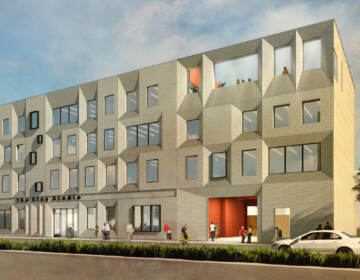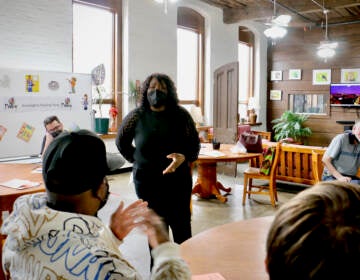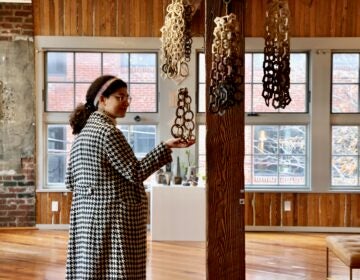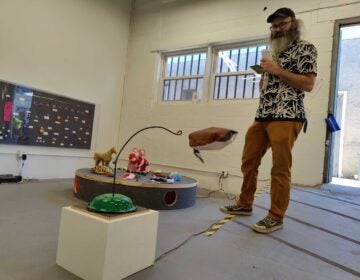The Clay Studio opens new building in Kensington, for Kensington
The purpose-built ceramics workshop and community space is designed with its neighbors in mind.
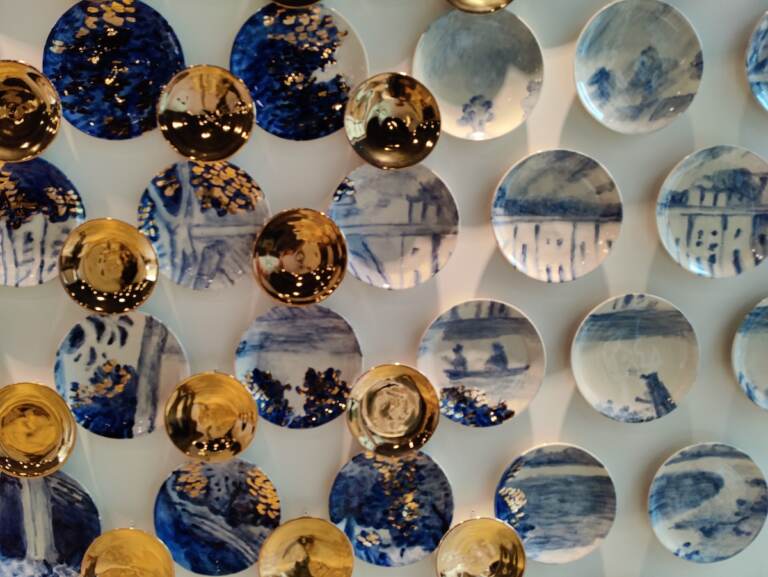
The inaugural exhibition, ''Making Place Matter,'' opens on April 23. It will feature this wall installation of plates by Molly Hatch, inspired by a painting of rowers on the Schuylkill River, at the Philadelphia Museum of Art. (Peter Crimmins/WHYY)
Before the new Clay Studio building opened in Kensington last weekend, Executive Director Jennifer Martin and a reporter christened the building by making the very first pieces in the newly constructed pottery facility.
It was also the first time I’ve ever attempted to form clay on a throwing wheel.
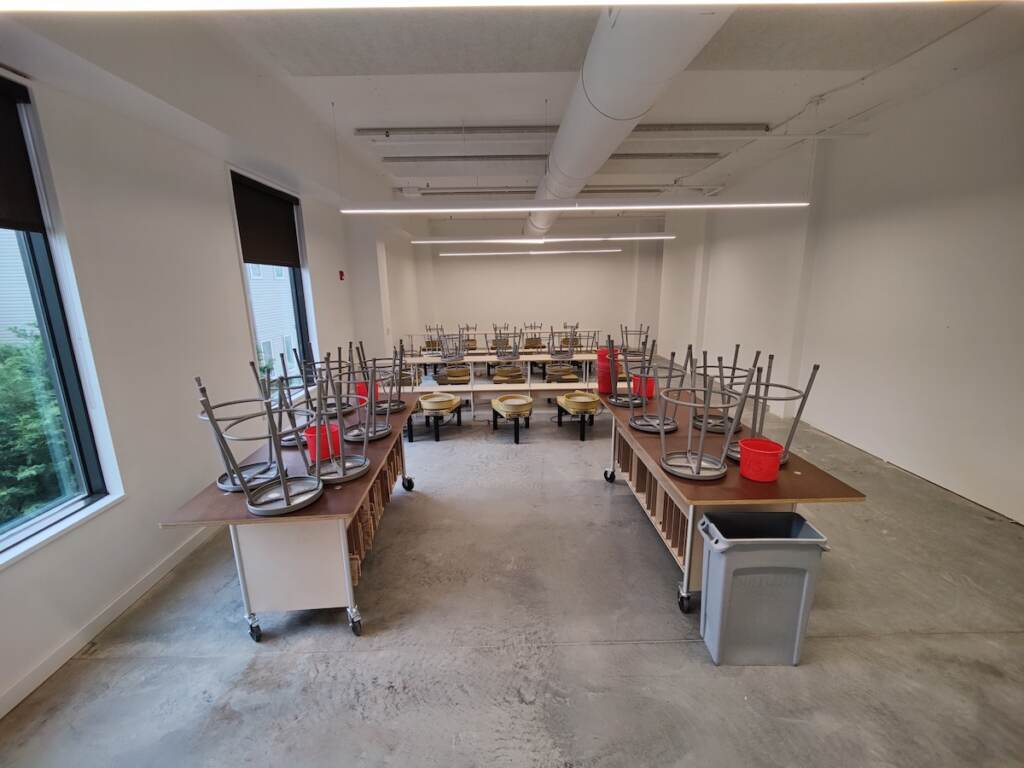
“Here’s the fun part,” Martin said, showing me how to plunge a thumb into the center of a spinning clay wad to form a depression.
It did not go well. Instead of rising into a gracefully-shaped wall of a bowl, my clay spun out of control into a freakishly disfigured mess.
“Well, that happened,” I said. “Is this repairable?”
Martin leaned over to my wheel and tried to wrestle the clay into something resembling a vessel.
“I’ve made it worse,” she said. “Next!”
The clay went back into the bin and she gave me a new clay ball to start over with.
This building is a new start for the Clay Studio. The 48-year-old organization has been cramped in a double-wide storefront building on 2nd Street since 1980. This building on North American Street is not only purpose-built from the ground up to give the organization more room – going from 21,000 to 34,000 square feet – but allows the Clay Studio to engage in what Martin calls “radical hospitality.”
“The building is literally designed around community and collaboration and exchange of ideas at every turn throughout the space,” Martin said. “That’s why the building is a cultural shift for the organization. We have spaces to come together. You may be an amateur that’s never touched clay before and you’re interacting with an international artist who is a professional in the field. Everyone is equal.”
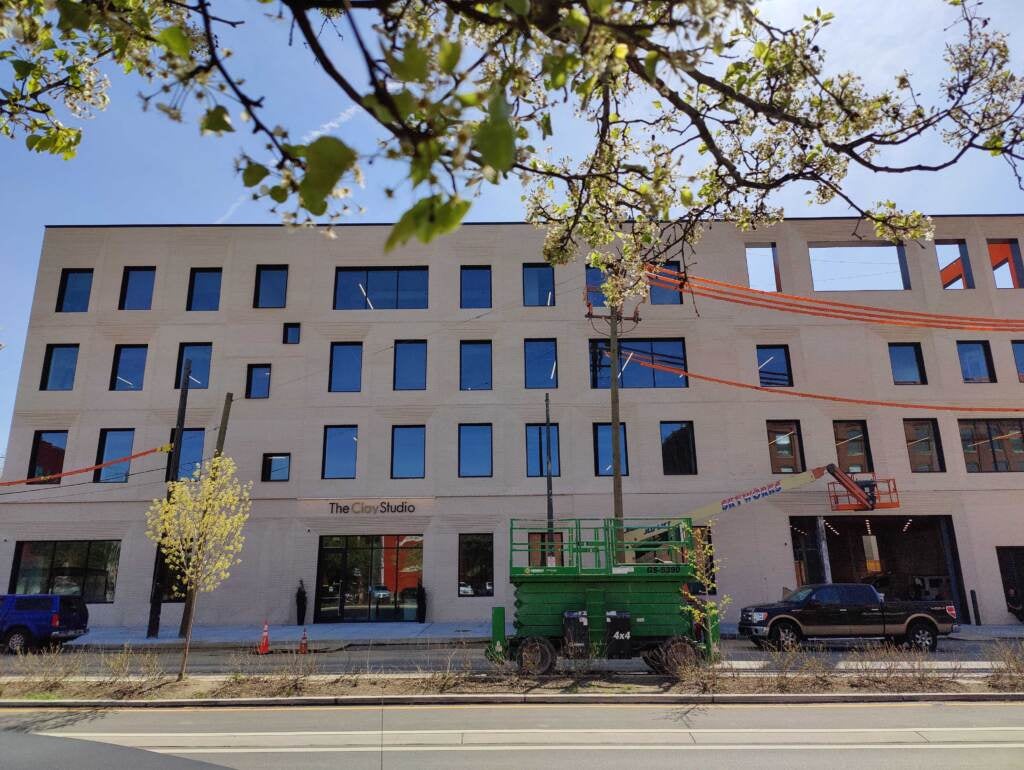
Martin said she scoured the city looking at empty buildings that could be repurposed into a large-scale ceramic workshop, gallery, and community space.
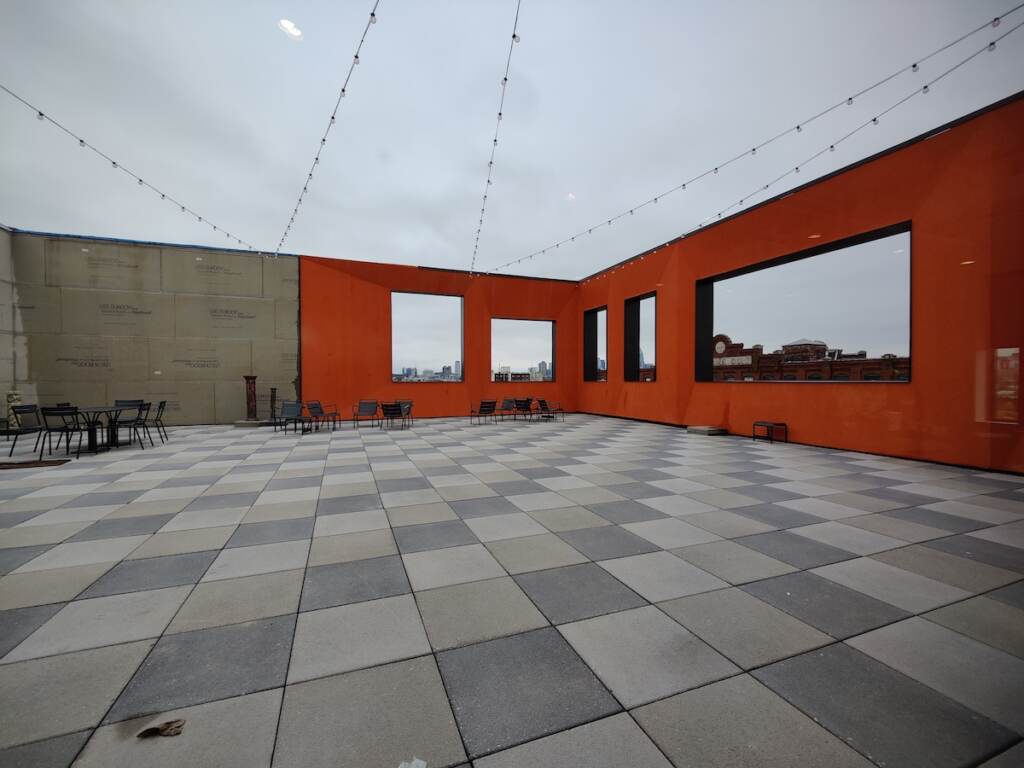
She finally settled on a vacant lot in Kensington to custom-design a new construction along a corridor where other artists and artisan spaces are established: across the street is the Crane Arts building filled with artist studios, exhibition spaces, and the TILT Institute for the Contemporary Image; up the street is the Next Fab maker space.
The four-story building not only has dedicated spaces for each phase of ceramics — a design room, a throwing room, a glazing room, firing kilns — it also has spaces reserved for after-school children’s programs, amateur adult classes, and professional artist studios.
There are also spaces just for community events: a roof deck, a lecture auditorium, and a street-level viewing area where passersby can watch artists at work.
Later this month, the inaugural exhibition “Making Place Matter” will open in the art gallery with work by three artists based in the United States — Kukuli Velarde, Molly Hatch, and Ibrahim Said — who have created work interpreting their distinct heritages from Peru, Britain, and Egypt.

The exhibition will be accompanied by a symposium in June around modern ceramic art that is geographically specific.
“We were really thinking about the idea of moving from one place to another, and what that would mean for our organization and what it would mean for the neighborhood we were moving to,” said curator Jennifer Zwilling.
Both the exhibition and the building itself were designed in consultation with community advisory committees. The Clay Studio asked artists, longtime collaborators, and residents of the Kensington neighborhood to convene several times over the last five years to talk about what it means for the Clay Studio to relocate to North American Street and how it can best accommodate its new neighbors.
“They really did it correctly,” said Meliza Reynoso, a longtime Kensington resident who works with the Norris Square Neighborhood Project.
She said that when a large organization plans to drop anchor in her neighborhood, “there’s a good way, and there’s no way.”
“The bad way is when you come in and just start taking spaces, literally and figuratively, and don’t ask anyone who’s been here,” she said.
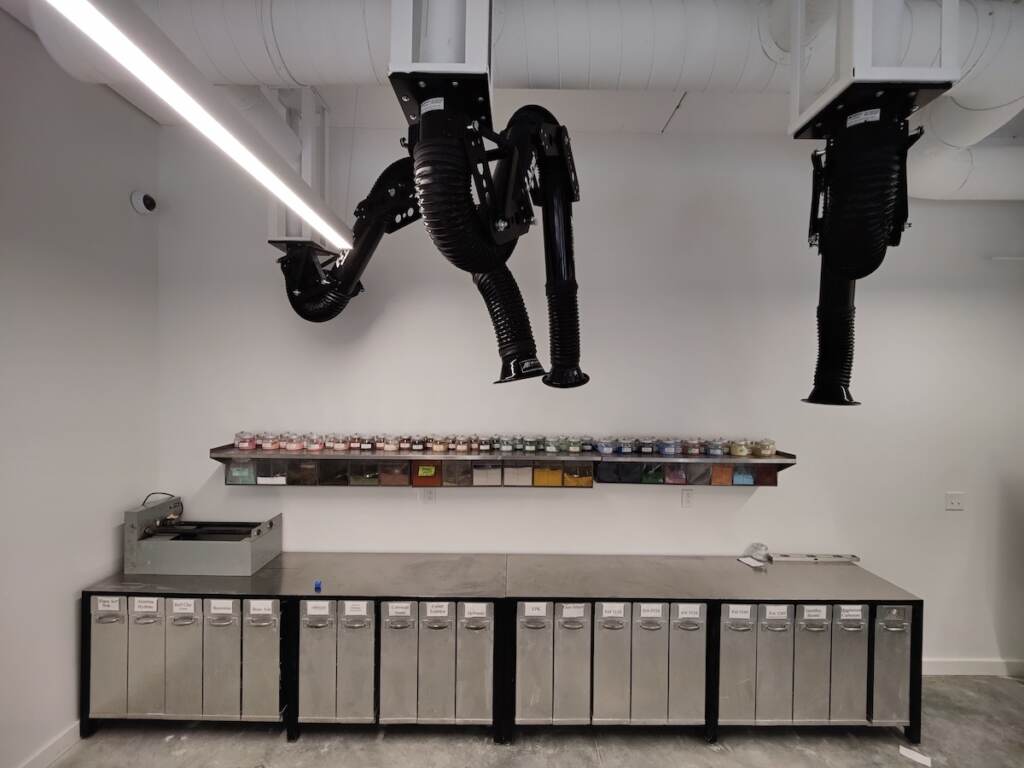
Years ago, Reynoso was first invited by the Clay Studio to make ceramics in free weekly classes in the neighborhood. While hands were busy in those workshops, people from the Clay Studio would start asking the neighbors for their input on how the organization could best incorporate the neighborhood into its programming.
Later some of those participants, including Reynoso, were asked to join a community advisory committee. She appreciated that the events were organized in the neighborhood itself, rather than asking people to travel downtown to the old Clay Studio building.
“We never met at 2nd Street,” said Reynoso. “Not once.”
Another community member, Annie Moss of the Olde Kensington Neighborhood Association, participated in a community carpentry workshop to build benches for the Clay Studio, and then was asked to sit on an advisory committee.
Moss, who works with youth in the area, hopes the Clay Studio will have youth programs that will be accessible to everyone in the neighborhood, year-round, seven days a week.
“I look at Clay Studio like being a school,” she said. “If they have something nearby that they can reach out to, and it’s free, or moderate, or scholarships that we can do for them — that’s just awesome. That’s what we try to do: sustain our community and build future leaders.”
That enthusiasm for what the Clay Studio might do for Kensington is tempered with caution. As Reynoso said, the neighborhood has been burned before by promises.
“They have done everything right so far. I hope it continues now that this thing is built,” she said. “You’re here now. You’re one of us, so you’re going to be one of us. You’ve got to let us come in.”
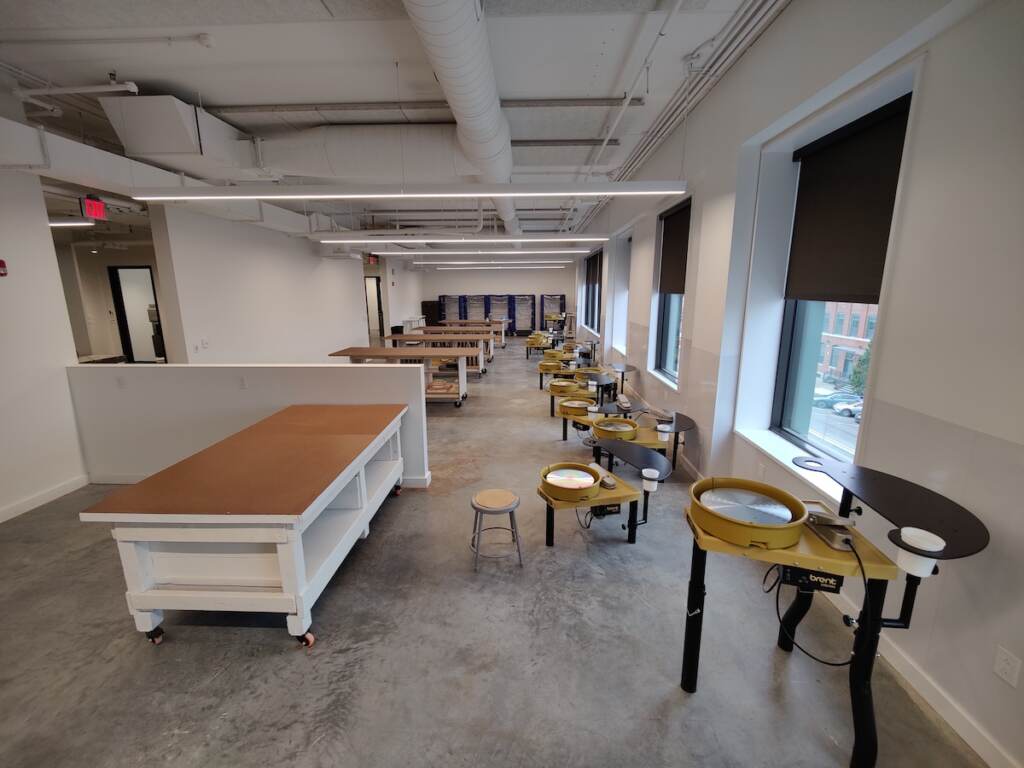

Saturdays just got more interesting.
WHYY is your source for fact-based, in-depth journalism and information. As a nonprofit organization, we rely on financial support from readers like you. Please give today.



